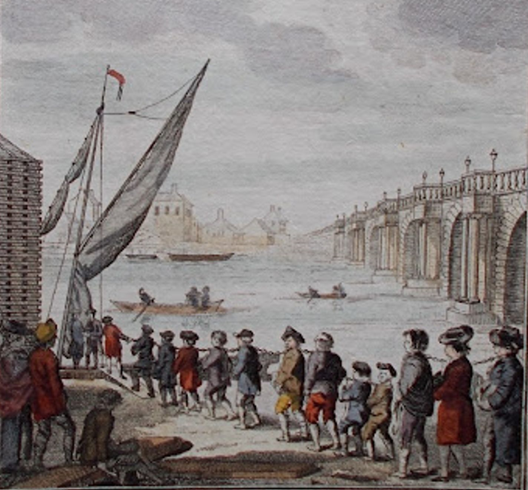Going on Board
11/6/20242 min read


‘The Convicts taking Water near Blackfriars Bridge’ (Newgate & Tyburn Calendar, 1779, British Library)
The early morning parade of shackled prisoners marching down from Newgate prison to the lighters at Blackfriars Bridge was a ritual that went back to the early days of American transportation. For the spectators, it was an entertaining and at times terrifying spectacle, with the convicts singing, shouting and swearing, snatching hats, breaking windows and stealing watches as they went. From time to time, someone would escape.
Prisoners from country gaols were transported to the ships in wagons or small coastal vessels, and convicts from Newgate were occasionally sent down to Portsmouth or Plymouth in wagons.
On coming aboard, the prisoners would be searched and secured. The surgeons would conduct basic health checks and from time to time, some of the convicts would be found unfit for the voyage and sent back, although it seems that the ships’ surgeons had only limited authority to turn them away.
The more progressive county gaols no longer kept their inmates in chains, but shackles were necessary while they were being transferred. These would be removed on going aboard and the men would be fitted with a new set of irons. Double irons were often used to begin with, and the unruly might also be manacled. Unless they misbehaved, the women were not ironed on board the ships since they were not seen as a security risk.
By the end of the decade, the men would routinely be washed and their heads shaved on coming aboard, and they would all be given a new set of clothing – this helped in managing the body lice through which typhus was spread.
The men would be physically searched but not the women, since this could not have been done with propriety. Undoubtedly, some of the women took advantage of these scruples to smuggle contraband. Their boxes and trunks, however, were closely searched, and it was usual for metal objects, which might be used to create saws or knives, to be taken away.
The convicts would also hand over their valuables to the ships’ officers for safekeeping, although some preferred to take the risk of keeping them close at hand.
Having been shown to the prison and assigned their berths, the convicts would be issued with bedding – a canvas mattress stuffed with straw, a pillow, a blanket and possibly a rug. They would also be assigned to their messes, usually the naval mess of six, the organisational unit used for issuing water and provisions, cooking and eating meals, and sometimes undertaking cleaning duties.
On most ships, well-to-do convicts could pay to have their own cabin at some distance from the other prisoners, and there is evidence that middle-class convicts, and prisoners who had been in service in one of the great houses, could pay a small sum to mess together.
Contact us
Connect with us
Botany Baymen acknowledges the traditional custodians of country throughout Australia and respects their connection to land, water and community.
© Botany Baymen 2024. All rights reserved.
You may download, display, print and reproduce this content for your personal or non-commercial use but only in an unaltered form and with the copyright acknowledged.

